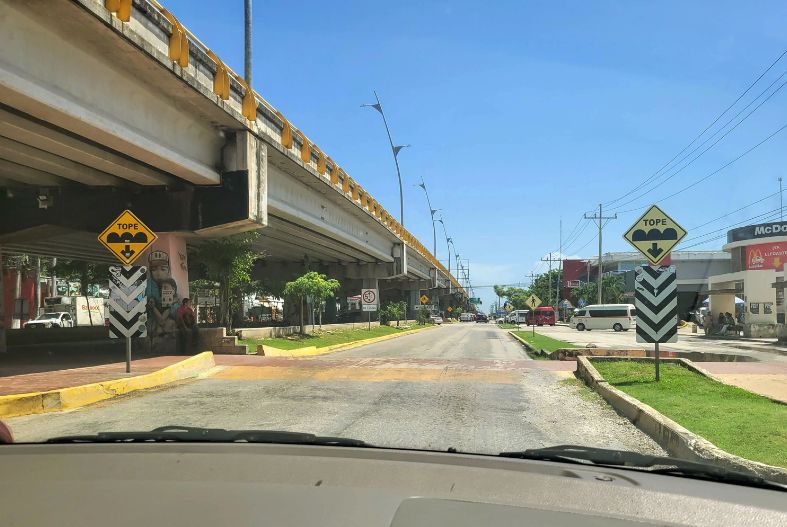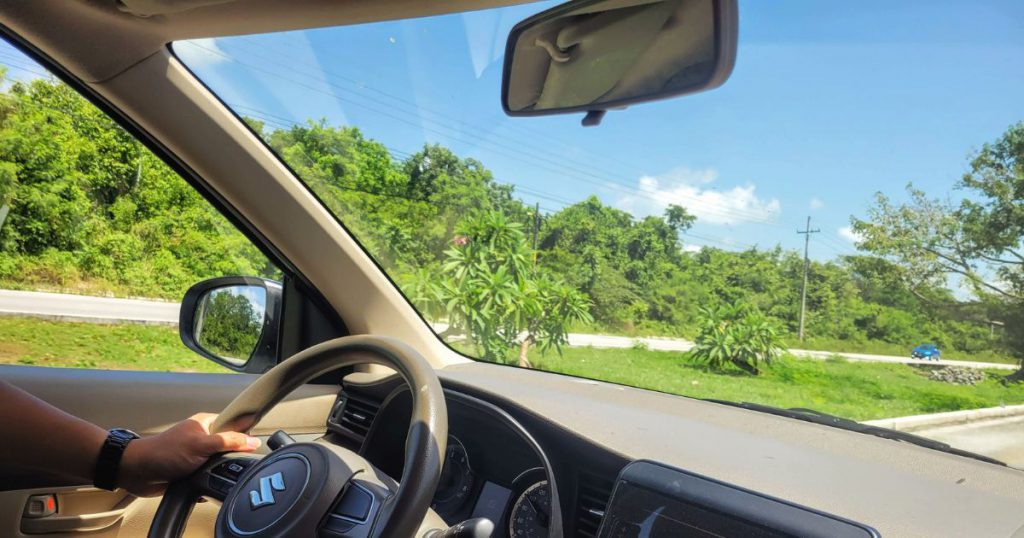This page may contain affiliate links, which means that we may earn from qualifying purchases at no additional cost to you.
If you’re considering renting a car in Mexico and driving in the Yucatan, we have all the information you need for a great experience!
When we first decided that it made the most sense to rent a car for our trip to the Yucatan, we were somewhat stressed about the idea of driving in Mexico. Although we’ve been to Mexico before, we weren’t really paying attention to the driving conditions since we weren’t driving ourselves.
But we were pleased to find that our worries were unfounded and we found driving in Mexico to be a pleasant experience, for the most part. We ended our trip glad that we had chosen the option of renting a car in Mexico and quick to encourage others to do so as well.
Read on for our best tips for driving in the Yucatan!
Tips and take-aways for driving in the Yucatan
Foreign drivers licenses are valid
If you have a driver’s license from your country, there’s nothing more that you need to do to be able to drive in Mexico. Foreign licenses are valid in Mexico with your passport and will be accepted by rental companies and police as legitimate (although you do need to be at least 21 to rent a car, with additional charges for those between 21 and 24).
Drivers are surprisingly accommodating
Over the course of our travels, we’ve visited many places where I would never want to drive in a million years. However, we were pleasantly surprised with our experience driving in Mexico.
The drivers really aren’t aggressive and are willing to yield and accommodate hesitant drivers. They also tend to adhere to the rules of the road and obey traffic laws. With a few notable exceptions, which we’ll get into below, it really didn’t feel all that different from driving in the US. This might not be true for other areas of Mexico, but it was true of our experience driving in the Yucatan.
Watch out for speedbumps


Speed bumps, or topes, in Mexico are extremely effective at slowing cars down because if you hit them full speed your world will be completely rocked and there’s a good chance you’ll break something in your car.
That being said, you would think they would be better marked, but they tend to sneak up on you when you least expect them.
These speed bumps are unlike anything I had ever seen anywhere else. They are typically much larger than the speed bumps that you’ll find in the US and can pop up not only in a pedestrian area or school zone, but also when you’re flying along a highway at full speed.
Stay alert, watch for the signs, and know that often the bump itself isn’t marked in any way, so it blends in with the road until you’re right on top of it.
This obviously is not a necessity as there are a lot of great international companies that you can go with as well.
We just had a really great experience using a local company called Say Yes! Car Rental. They had a much better rate than the comparable international companies and were much more accommodating than other companies would have been when our plans kept changing. We were able to extend our rental for several extra days just by texting them with no hassle at all.
Be aware when you’re booking a car in Mexico that you need to factor in the cost of insurance, which, if not required, is very strongly encouraged to avoid huge liability. This cost is often not listed in the quoted price for renting a car.
Beware of gas scams
When we rented a car the rental company warned us about common gas scams in Mexico, which we had also heard about in our own research for our trip.
There are a couple of common scams that tourists are often prey to.
- The first one is swapping out the large bill you gave them for a smaller bill (often a 500 for a 50, which look similar), and then claiming you didn’t give them enough money. To prevent this scam, count out the money in front of them and have them acknowledge the amount before you ever hand it over so that they know that you’re aware of exactly how much cash you gave them.
- The next scam is not zeroing out the pump before they begin pumping, meaning you’re actually getting less gas because they’re including the previous person’s purchase. To avoid this, get out of your car when you drive up and watch to make sure that they have zeroed the pump before they begin pumping your gas.
- Another scam is discreetly putting some of the gas into another container instead of into your gas tank when they’re pumping. You think you’ve paid for a certain amount of gas, but the gas isn’t really going into your tank. To avoid this, stand outside and watch for the entire time the gas is being pumped.
The best thing you can do to avoid being scammed is show the gas attendant that you are alert and paying attention to everything they are doing. Get out of your car, make eye contact, and pay attention during the entire transaction. You can still be friendly and polite of course, just make sure they recognize that you aren’t an easy mark.
We did all these things and never had a problem being scammed at a gas station while we were driving in the Yucatan.
Try to avoid driving at night
When possible, it’s best to avoid driving at night in Mexico. While there are rare instances of robbery or organized crime targeting travelers at night, that’s typically not the biggest problem you have to worry about.
When traveling at night, it’s harder to see people or animals that might be on the road, not to mention those dreaded speedbumps. There’s also a greater risk of accident due to drunk drivers or other drivers not using headlights. And it can be challenging to navigate in places where there might be burnt out street lamps or hard to read signs.
That being said, we did actually drive at night a few times out of necessity and we didn’t run into any problems at all. Avoid it if you can, but don’t stress it too much if you end up having to drive at night while you’re there.
On-ramps are short!


Entering the freeway from an on-ramp was by far the most stressful part of driving in Mexico for me.
The onramps in the cities are often so short that you have to come to a complete stop to see what’s going on in traffic and then try to gun it to dart into a gap in traffic.
Luckily drivers are accommodating and always made room for us, but it was so anxiety-inducing for me whenever I knew we had to enter the freeway.
Know that sometimes the rules of the road disappear
By and large, we found that the rules of the road were respected the way we would expect them to be in the US. However, there were instances where they were completely disregarded.
For example, when we were in heavy traffic headed to the airport the two lane road suddenly became a three lane road with cars forcing their way into the narrow side median. I was honestly shocked that the cars could even fit in that space and saw more than a few close calls as drivers pushed their way through, sometimes with mere inches to spare.
Be prepared for toll roads
Plan your routes ahead of time so you can be aware if there are any toll roads where you will be driving. Often there are ways to get around toll roads, but the toll roads are often better maintained, more direct, and will have less traffic.
Tolls typically must be paid in cash only and only pesos are accepted, so you’ll want to make sure that you are carrying enough cash to cover the cost of tolls.
Know the basic road signs and rules of the road
When driving in a new place, you want to make sure you know what the signs mean and how the rules operate. Here are a few of the big ones:
- Alto means stop. This is pretty easy to figure out due to the shape and color of the sign, but still good to know.
- Parking in Spanish translates to Estacionamento, so if you see a sign with an E in a circle it means you can park there. If the E has a line through it, it means no parking.
- When you’re behind someone on the highway and they use their left turn signal, they’re signaling that you should pass, not that they are changing lanes.
- When a car puts their hazards on, it typically means that they are slowing down suddenly.
Be aware of police checkpoints and police lights


Along the road you’ll see police checkpoints at frequent intervals. Slow down as you’re approaching, but unless a police officer waves you over, just keep on driving through. We were never stopped at a police checkpoint and only once did we ever see anyone else stopped there either. As long as you don’t have drugs or weapons, you shouldn’t have a problem even if you’re stopped at a checkpoint.
Another thing to know is that if a police car is driving around with its lights on, it doesn’t actually mean anything unless it is accompanied by a siren or direction to pull over. If you see a police car with just its lights on, you don’t need to pull over.
Watch out for one way streets
There are lots of one-way streets in Mexico, and you don’t want the unfortunate experience of driving the wrong way down one of these streets. You can tell when a street is a one-way street if there is an arrow on the stop sign at the street’s entrance.
We used Google maps to navigate during our trip, and never had a time where it tried to send us the wrong way down a one-way street. Google maps was also hugely stress-reducing in that we didn’t have to stress about the navigation, we could just focus on the road conditions.
Common Questions
Is Yucatan safe for driving?
Yes, the Yucatan is safe for driving. If you’re traveling to more remote areas it really is the best way to get around and gives you a lot of flexibility in your trip. Obviously use common sense, follow the traffic laws, and follow the tips provided in this guide.
Is it safe for tourists to drive in Mexico?
This is similar to the question above, but yes, it is safe for tourists to drive in Mexico. If you’re comfortable driving in cities in the US or wherever you’re from, you’ll be fine driving in the Yucatan. Although there are some things that are different, it’s pretty easy to figure out, especially if you do a little research beforehand (like reading this article!).
You are also unlikely to get held up by police or gangsters, which is another common concern for tourists.
Is driving in Mexico difficult?
Driving in Mexico was not nearly as difficult as we thought it might be. Obviously there’s a learning curve whenever you drive in a new location, but we both felt comfortable driving there (even me, who doesn’t even like driving in the US sometimes!).
One thing that helped us is that in Mexico they drive on the right side of the road, which is what we’re used to, being from the US. If you’re from a country where you drive on the left side of the road, obviously that will be an additional challenge.
Final Thoughts
While renting a car in Mexico can seem stressful, it’s actually not that challenging if you know what to expect.
We had a wonderful experience driving in the Yucatan and were so grateful for the increased flexibility that having a car provided.
Other posts you might be interested in:
Playa del Carmen with Kids- Best Things to Do and Tips for a Great Trip!
What to Know Before Visiting Chichen Itza with Kids
Xcaret Park Review- Best Attractions and Helpful Tips for a Amazing Visit!





